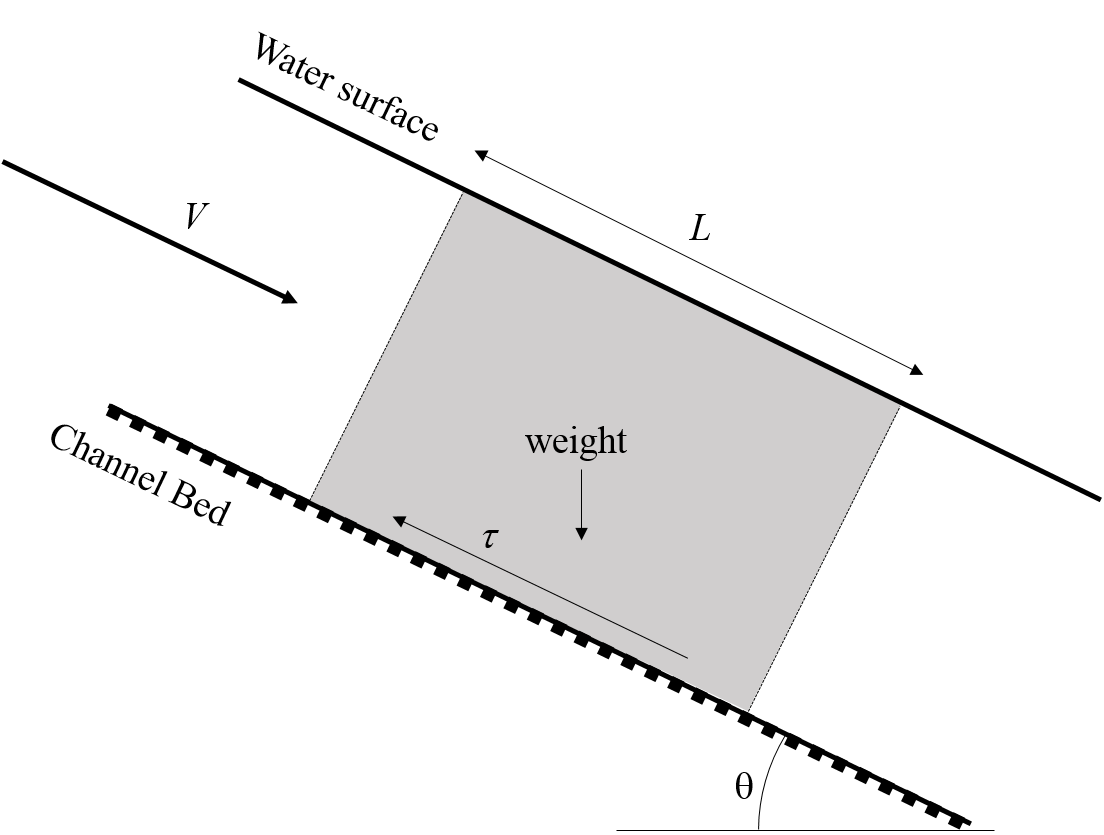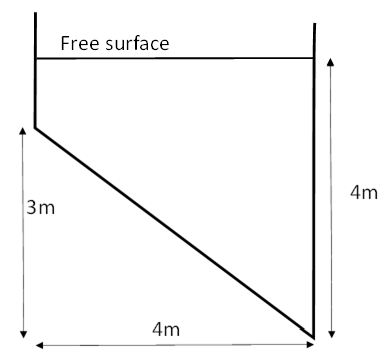2 Uniform Flow in Open Channels
2.1 Uniform flow and the Development of Friction formulae
When uniform flow occurs gravitational forces exactly balance the frictional resistance forces which apply as a shear force along the boundary (channel bed and walls).

Considering figure 2.1, the gravity force resolved in the direction of flow is
and the boundary shear force resolved in the direction of flow is
In uniform flow these balance
Considering a channel of small slope, then
So
2.1.1 The Chezy equation
If an estimate of can be made then we can make use of Equation 2.5.
If we assume the state of rough turbulent flow then we can also make the assumption the shear force is proportional to the flow velocity squared i.e.
Substituting this into equation 2.5 gives
Or grouping the constants together as one equal to
This is the Chezy equation and the the ’Chezy ’
In terms of this is simply
Because the is not constant the is not constant but depends on Reynolds number and boundary roughness (see discussion in previous section).
Although not a specific practical use, as a purely technical interest, the relationship between and can easily be seen by substituting equation 2.7 into the Darcy-Wiesbach equation written for open channels to show
2.2 The Manning’s equation
Very many studies have been made on the evaluation of C for different natural and man-made channels. These have resulted in today where most practising engineers use some form of this relationship to give :
This is known as Manning’s formula, or the Manning’s equation, and the as Manning’s .
Substituting equation 2.10 in to 2.7 gives velocity of uniform flow:
Or in terms of discharge
Or as
Note:
Several other names have been associated with the derivation of this formula - or ones similar and consequently, in some countries the same equation is named after one of these people. Some of these names are; Strickler, Gauckler, Kutter, Gauguillet and Hagen. See for example this informative web page https://en.wikipedia.org/wiki/Manning_formula.
The Manning’s is also numerically identical to the Kutter .
Manning’s equation has the great benefit that it is simple and accurate, and now, due to its long extensive practical use, there exists a wealth of publicly available values of for a very wide range of channels.
Below is a table of a few typical values of Manning’s
| Channel type | Surface material and form | Manning’s range |
| River | earth, straight | 0.02-0.025 |
| earth, meandering | 0.03-0.05 | |
| gravel (75-150mm), straight | 0.03-0.04 | |
| gravel (75-150mm), winding | 0.04-0.08 | |
| unlined canal | earth, straight | 0.018-0.025 |
| rock, straight | 0.025-0.045 | |
| lined canal | concrete | 0.012-0.017 |
| lab. models | mortar | 0.011-0.013 |
| Perspex | 0.009 |
Appendix A has further details of the Manning’s equation written in different forms as well as for commonly shaped channels: rectangular, trapezoidal, circular and wide. It is very important that you look at this appendix.
2.2.1 Conveyance
Channel conveyance, , is a measure of the carrying capacity of a channel. The is really an agglomeration of several terms in the Chezy or Manning’s equation:
| (2.14) |
So
The use of conveyance is sometimes convenient when calculating discharge and stage in compound channels (e.g. channels with a main channel and a flood plain) and also calculating the energy and momentum coefficients in this situation.
2.3 Computations in uniform flow
We can use either the Chezy or Manning’s equations for discharge to calculate steady uniform flow. Two calculations are usually performed to solve uniform flow problems.
-
1.
Discharge from a given depth
-
2.
Depth for a given discharge
In steady uniform flow the flow depth is known as normal depth.
We will continue the discussion based on the Manning’s equation, as that is the most common in practise. However all uniform flow computations described in the following text could also be done using the Chezy equation (with an appropriate Chezy C prescribed).
As we have already mentioned, and by definition, uniform flow can only occur in channels of constant cross-section (prismatic channels) so natural channels can be excluded. However we will need to use Manning’s equation later for gradually varied flow in natural channels - so application to natural/irregular channels will often be required.
2.3.1 Uniform flow example 1 - Discharge from depth in a trapezoidal channel
A concrete-lined trapezoidal channel with uniform flow has a normal depth of 2m. The base width is and the side slopes are equal at 1:2 (v:h, or in table 1.2) Manning’s can be taken as , And the bed slope
What are:
-
a)
Discharge ()?
-
b)
Mean velocity ()?
-
c)
Reynolds number ()?
Calculate the section properties, using the appropriate geometrical formulae (e.g. table 1.2)
Area,
Wetted perimeter,
Use equation 2.13 to get the discharge
Calculate the mean velocity using the continuity equation:
And the Reynolds, , number (remember we use the hydraulic radius as the length scale), and so using )
This is very large - i.e. well into the turbulent zone - the application of the Manning’s equation was therefore valid.
What solution would we have obtained if we had used the Colebrook-White equation which takes into account the changes in roughness with ?
The likely hood is that results would be very very similar (negligibly so) as, looking at the , we are well into the rough-turbulent zone where a constant friction value is truly applicable.
To investigate further with the Colebrook-White equation, an equivalent value can be calculated for the discharge obtained from and [] (Using the Colebrook-White equation and the Darcy-Wiesbach equation of open channels - both given earlier). Then a range of depths can be chosen and the discharges calculated for these and values. Comparing these discharge calculations will give some idea of the relative differences - they will be very similar.
2.3.2 Uniform flow example 2 - Depth from Discharge in a trapezoidal channel
Using the same channel as above, if the discharge is known to be in uniform flow, what is the normal depth?
Again use equation 2.13
And substituting using
Area,
Wetted perimeter,
We need to calculate from this equation (and remember that this is normal depth so .
Even for this quite simple geometry, the equation we need to solve for normal depth is complex (and not explicit).
One simple strategy to solve this is to try some trial values of and calculate the right-hand side of this equation and compare it to on the left. When it equals we have the correct . Even though there will be several solutions to this equation, this strategy generally works because we have a good idea of what the depth should be (e.g. it will always be positive and often in the range of ).
In this case from the previous example, we know that at , . So at then .
| Trials of () | Discharge () |
| 1.7 | 32.7 |
| 1.6 | 29.1 |
| 1.63 | 30.1 |
2.3.3 Uniform flow example 3 - Calculation of Uniform Flow and Froude Number
Find the discharge in the channel shown in figure 2.2 that is flowing with uniform flow of depth , as shown below, and has a bed slope is 1 in 1000 and a Chezy of . Is this flow sub or super-critical?

We have uniform flow and the friction is specified by the Chezy friction factor, so use the Chezy Equation (equation 2.8):
Slope:
Flow area:
Wetted perimeter:
Hydraulic radius:
Hydraulic mean depth:
Therefore the discharge in the channel is
And the velocity of flow is
To calculate whether the flow is sub or super-critical then we must calculate the Froude number using equation 1.31.
As , it is sub-critical flow.
2.3.4 Uniform flow example 4 - A compound channel
The channel shown in figure 2.3 has been designed so that usually the water flows in the lower trapezoidal section in the middle (region 1). During high flow conditions (e.g. flooding) the water level will rise above this and will be flowing across the full section including the two floodplains of regions 2 and 3.

With the flood channels dimensions as shown and the Manning in the main channel and on the banks estimated as and respectively, what is
-
a)
the discharge for a flood level of (measured from the lowest point of the cross-section)?
-
b)
the energy coefficient ?
First, split the section as shown into three regions (this is arbitrary and left to the engineers’ judgment). Then apply Manning’s formula for each section to give three discharge values and the total discharge will be .
Calculate the properties of each region:
The conveyance for each region may be calculated from equation 2.15
And from Equation 2.13 or Equation 2.14 the discharges
or
And
or
So
The velocities can be obtained from the continuity equation:
And the energy coefficient may be obtained from Equation 1.15
where
Giving
This is a very high value of and a clear case of where a velocity coefficient should be used.
Note that this method does not give a completely accurate relationship between stage and discharge because some of the assumptions are not accurate. E.g. the arbitrarily splitting into regions of fixed Manning is probably not what is occurring in the actual channel. However, it will give a good estimate as long as care is taken in choosing these regions.
2.4 Efficient Uniform Flow Channels
The design of a rigid (i.e., non-erodible) surface open channel should be such that it is capable of carrying maximum discharge with minimum excavation, construction, and lining costs. This suggests minimising the friction which also suggests that the designed channel should have a maximum hydraulic radius for a given area or minimum perimeter for the given area since hydraulic radius equals . Therefore, a circular or semi-circular cross-section is the most efficient section. The use of a circular channel section is usually not feasible for sections larger than when a pipe could be used, due to the difficulties of construction to achieve stable earth slopes and other practical considerations. Hence, the designer has to determine the most efficient section of a given shape. Considering a trapezoidal channel section, Fig. 2.4, the area of flow section and the wetted perimeter are given as
Here,

On substituting the value of obtained from Eq. 2.16 into Eq. 2.17, one gets
To minimize , evaluate with and constant and set equal to zero. Therefore,
or
Substituting the expression for into Eq. 2.16, one gets
Likewise, substituting the value of from Eq. 2.19 in Eq. 2.18, one gets
or
Thus,
Equation 2.22 indicates that for any side slope (or ), the most efficient uniform flow channel of trapezoidal shape would be the one for which the hydraulic radius is half the depth of flow.
For a rectangular section, 90 or 0. Therefore, the most efficient rectangular channel section would be the one for which
To obtain the depth of flow for the most efficient section, these equations must be solved in conjunction with the Manning’s equation.
Equations 2.19, 2.22 are valid for any value of . The best value of for given and can be obtained by setting , evaluated from Eq. 2.18, equal to zero.
Thus, the maximum-flow trapezoidal section would be half of a hexagon.
Similarly, one can show that a circular channel section running partially full would perform best when the depth of flow is half the diameter. Geometric elements of the most efficient channel sections of some selected shapes are given in Table 2.3. Obviously, the semi-circular open channel section is the best of all possible channel sections as it gives the minimum wetted perimeter for a given area of flow section. However, the percentage increase in discharge for semicircular section, compared to that in semi-hexagonal section is only small.
| Cross-section | Normal | Area, | Wetted | Hydraulic | Water surface | Hydraulic |
| depth, | perimeter, | radius, | width, | depth, | ||
| Rectangular | ||||||
| Triangle | ||||||
| (side slope 1:1) | ||||||
| Trapezoid | ||||||
| (half of a hexagon) | ||||||
| Semicircle | ||||||
| Parabola | ||||||